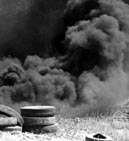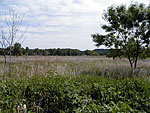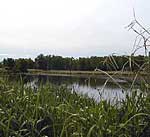The Sins of Pig's Eye
By Mary Losure
June 19, 2000
Some places are called landfills. Pig's Eye was a dump. Beginning in the 1950s, it was the unofficial drop-off point for more than a half-million tons of household junk, city garbage, lead acid batteries, barrels of toxic waste, and more. It's leaked pollution into nearby Pig's Eye Lake and the Mississippi River ever since. Now, the state is finally moving to try to contain the problem.
THE PIG'S EYE DUMP sits on a wetland on the Mississippi River, so close to downtown Saint Paul that you can see the city skyline and the state Capitol dome.
"There was a continuous line of trucks dumping everything you could imagine down there, drums of different kinds of liquids and chemicals, batteries, industrial dumping, all kinds of different dumps," says 79-year-old Robert Nelson of Saint Paul, who remembers it in its heyday. "You see the stack of pictures I've got over there, we've got a thousand pictures that MECCA took of the dumping."
MECCA is the Metropolitan Environmental Control Citizens Association. Nelson was one of its founders in 1968. The photos show mounds of garbage piled by the shore of Pig's Eye Lake, smoke billowing from burning tires, trash afloat in a Mississipi flood. MECCA tried in vain to get the dumping stopped.
"To us it was a pretty obvious, really a criminal thing to do; it just shouldn't have been allowed. We kept publishing the pictures, showing them to the people that were in charge, but no matter how much we talked to the mayor , the city council, it was like it was preordained; there was no way to get out of having a place for dumping."
The dump finally closed in 1972, after the Minnesota Pollution Control Agency refused to give Pig's Eye a permit. Today, the garbage covers an area more than three times the size of the Mall of America, piled more than a story deep.
Now it's buried beneath layer of earth, overgrown with tall grass. A creek winds through it, toward a distant grove of cottonwood trees. With the picturesque bluffs of the Mississippi as a backdrop, it looks almost like a park, right next to Pig's Eye Lake. So when Sheldon Johnson heard his neighborhood district council had a Pig's Eye task force, he volunteered.
"It wasn't until I'd been on that task force about a year that I heard some folks mention that this was the old Pig's Eye dump site," he said.
Johnson began digging around in the files of the Minnesota Pollution Control Agency.
"There's a lot of documentation, there's been five major reports done on this site. There are heavy metals, cadmuim, lead mercury. There are pestcides PCBs; all this stuff was leaching into Battle Creek , which runs through the middle of the dump, as well as into Pig's Eye Lake and then, of course, into the Mississipi River."
Johnson began lobbying the Minnesota Pollution Control Agency to do something. He went to local environmental groups, and politicians including State Senator Randy Kelly of Saint Paul. Kelly got the state Legislature to free up more than $2 million of state superfund money this session. But the cleanup poses daunting problems.
"A lot of the traditional remedies that you'd use for a case like this, for instance a pump out system, just would not work," Kelly says.
Frank Wallner heads the cleanup effort for the Minnesota Pollution Control Agency. The area is so wet, it's virtually impossible to pump the contaminated water out. Capping or lining the dump won't work, since much of the garbage rests below the water table in an area subject to flooding. Wallner says removing the waste entirely would be prohibitively expensive. So a total cleanup may be impossible.
"What we're hoping for is to reduce the levels of contaminents reaching Pig's Eye Lake, and we hope to obtain that by pulling back the garbage at the shoreline, or the interface between the dump and the lake, then laying a layer of clean organic soils to act as a bufffer zone."
For now, levels of mercury hundreds of times over acceptable limits are seeping into the lake and the Mississippi. Added to that are PCB levels, thousands of times higher than state water standards.
"Our main goal is to reduce that risk to the environment," says Wallner. "It's not really a public health hazard, it's more of an ecological hazard to wildlife and fish and so that's what's mainly driving the cleanup."
Asked why it took so long, Senator Randy Kelly, the chief Senate author of the cleanup bill, says the dump was simply "out of sight, out of mind." Also, it was difficult to pin down the blame for the problem. Major corporations like Ford, Whirlpool, and 3M used the dump, but Kelly says they were by no means the only ones.
"The City of Saint Paul is a very responsible party, the City of Minneapolis, I think there were like 28 communities that dumped waste there," says Kelly. "There were thousands of responsible parties. As a kid growing up on the east side, I remember going with pickups with my brother and dumping garbage there and so on; so I'm responsible too."
Sheldon Johnson, the citizen who brought the problem to Kelly's attention, is now running for the state Legislature. He's also pushing to have the old dump site made into a park; offering views of wildlife along with a lesson about past environmental mistakes. He pushes through the tall grass to a little pond in the midst of the dump. A couple of ducks paddle in the water, and turtles bask in the sun.
"It's kind of seductive, it looks great to the wildlife, but as you get closer and you look around you start seeing the effect of our 16-plus years of dumping right on the flood plain," Johnson says.
With his binoculars, Johnson scans the pond's shore. "Every once in awhile you see stuff percolating to the top. Plastic film, old tire, pieces of insulation. Old cement pieces. Old plastic hosing. It's all kind of weird."
The PCA plans to fill in or dredge out the pond, so its polluted water won't threaten wildlife. The agency has also begun removing some of the rusting barrels of toxic waste exposed along the creek bed.
The first ones contained PCBs. No one knows what the rest contain, or how many there are, since nobody ever kept track.
By Mary Losure
June 19, 2000
|
|
RealAudio 3.0 |
Some places are called landfills. Pig's Eye was a dump. Beginning in the 1950s, it was the unofficial drop-off point for more than a half-million tons of household junk, city garbage, lead acid batteries, barrels of toxic waste, and more. It's leaked pollution into nearby Pig's Eye Lake and the Mississippi River ever since. Now, the state is finally moving to try to contain the problem.
| |
|
|
|
||
"There was a continuous line of trucks dumping everything you could imagine down there, drums of different kinds of liquids and chemicals, batteries, industrial dumping, all kinds of different dumps," says 79-year-old Robert Nelson of Saint Paul, who remembers it in its heyday. "You see the stack of pictures I've got over there, we've got a thousand pictures that MECCA took of the dumping."
MECCA is the Metropolitan Environmental Control Citizens Association. Nelson was one of its founders in 1968. The photos show mounds of garbage piled by the shore of Pig's Eye Lake, smoke billowing from burning tires, trash afloat in a Mississipi flood. MECCA tried in vain to get the dumping stopped.
"To us it was a pretty obvious, really a criminal thing to do; it just shouldn't have been allowed. We kept publishing the pictures, showing them to the people that were in charge, but no matter how much we talked to the mayor , the city council, it was like it was preordained; there was no way to get out of having a place for dumping."
The dump finally closed in 1972, after the Minnesota Pollution Control Agency refused to give Pig's Eye a permit. Today, the garbage covers an area more than three times the size of the Mall of America, piled more than a story deep.
| |
|
|
|
||
"It wasn't until I'd been on that task force about a year that I heard some folks mention that this was the old Pig's Eye dump site," he said.
Johnson began digging around in the files of the Minnesota Pollution Control Agency.
"There's a lot of documentation, there's been five major reports done on this site. There are heavy metals, cadmuim, lead mercury. There are pestcides PCBs; all this stuff was leaching into Battle Creek , which runs through the middle of the dump, as well as into Pig's Eye Lake and then, of course, into the Mississipi River."
Johnson began lobbying the Minnesota Pollution Control Agency to do something. He went to local environmental groups, and politicians including State Senator Randy Kelly of Saint Paul. Kelly got the state Legislature to free up more than $2 million of state superfund money this session. But the cleanup poses daunting problems.
| |
|
|
|
| |
|
"A lot of the traditional remedies that you'd use for a case like this, for instance a pump out system, just would not work," Kelly says.
Frank Wallner heads the cleanup effort for the Minnesota Pollution Control Agency. The area is so wet, it's virtually impossible to pump the contaminated water out. Capping or lining the dump won't work, since much of the garbage rests below the water table in an area subject to flooding. Wallner says removing the waste entirely would be prohibitively expensive. So a total cleanup may be impossible.
"What we're hoping for is to reduce the levels of contaminents reaching Pig's Eye Lake, and we hope to obtain that by pulling back the garbage at the shoreline, or the interface between the dump and the lake, then laying a layer of clean organic soils to act as a bufffer zone."
For now, levels of mercury hundreds of times over acceptable limits are seeping into the lake and the Mississippi. Added to that are PCB levels, thousands of times higher than state water standards.
"Our main goal is to reduce that risk to the environment," says Wallner. "It's not really a public health hazard, it's more of an ecological hazard to wildlife and fish and so that's what's mainly driving the cleanup."
Asked why it took so long, Senator Randy Kelly, the chief Senate author of the cleanup bill, says the dump was simply "out of sight, out of mind." Also, it was difficult to pin down the blame for the problem. Major corporations like Ford, Whirlpool, and 3M used the dump, but Kelly says they were by no means the only ones.
"The City of Saint Paul is a very responsible party, the City of Minneapolis, I think there were like 28 communities that dumped waste there," says Kelly. "There were thousands of responsible parties. As a kid growing up on the east side, I remember going with pickups with my brother and dumping garbage there and so on; so I'm responsible too."
| |
|
|
|
||
Sheldon Johnson, the citizen who brought the problem to Kelly's attention, is now running for the state Legislature. He's also pushing to have the old dump site made into a park; offering views of wildlife along with a lesson about past environmental mistakes. He pushes through the tall grass to a little pond in the midst of the dump. A couple of ducks paddle in the water, and turtles bask in the sun.
"It's kind of seductive, it looks great to the wildlife, but as you get closer and you look around you start seeing the effect of our 16-plus years of dumping right on the flood plain," Johnson says.
With his binoculars, Johnson scans the pond's shore. "Every once in awhile you see stuff percolating to the top. Plastic film, old tire, pieces of insulation. Old cement pieces. Old plastic hosing. It's all kind of weird."
The PCA plans to fill in or dredge out the pond, so its polluted water won't threaten wildlife. The agency has also begun removing some of the rusting barrels of toxic waste exposed along the creek bed.
The first ones contained PCBs. No one knows what the rest contain, or how many there are, since nobody ever kept track.
| Next: Last Chance for the Higgins Eye |



